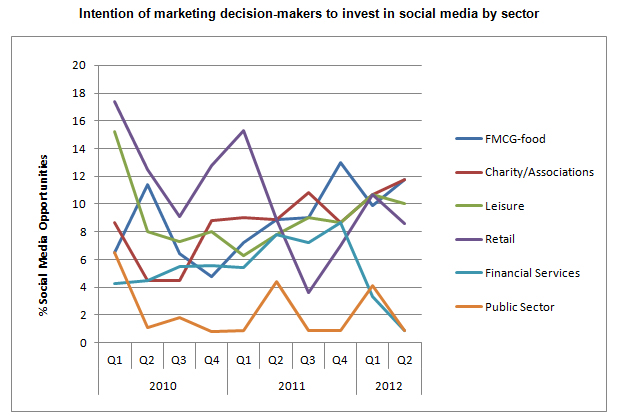Investment in social media marketing by financial services companies has declined sharply since the end of 2011. While in the last quarter of 2011, 22 percent of companies in the financial services sector were investing in social media, this fell to 8.5 percent in the first quarter of this year and six percent in the second quarter.

This represents an interesting about-turn. We saw financial sector investment in social media increase steadily over the past few years to reach the highest levels ever by the end of 2011. The sector noticed that social media was changing the way consumers interact with businesses and, as a result, companies were noticeably using social media both as a customer service channel and as a recruitment tool.
However, the financial world soon realised that social media also presented risks. Not only because financial information must comply with strict rules and regulations but, as financial services brands embraced new methods for communicating with customers, they also opened themselves up to criticism and negative sentiment.
With social media, everything is in the public domain, and this can be well outside of a financial institution’s comfort zone. The sector in general is quite conservative and many companies are using social media half-heartedly or in a token manner.
A number of recent high profile events have demonstrated how financial services companies are simply not comfortable with transparency and openness. Banks, for instance, are becoming very wary of social channels and many are reconsidering whether they should be investing in something that generates negative returns. From bonuses and system outages to accusations of laundering money, banks have been heavily criticised for staying mute on social channels when these crises occur.
Running six of the major high-street banks through social media monitoring software (Lloyds TSB, Barclays, RBS, HSBC, Co-operative and NatWest) reveals over 170,000 mentions on Twitter alone in the past 30 days. However, negative posts were twice as common as positive ones.
When it comes to spending on social media, marketing budget-holders in this sector are left wondering about the benefits, and many are simply putting spending on hold until they have developed a clearer picture of how social media can be harnessed to improve their brands.
We do, however, expect to see reinvestment in social media towards the end of the year, but it will be a delicate subject for many marketers in the sector. Especially for those who may feel the advice they’ve had thus far from consultancies hasn’t been good enough. Agencies that operate in this sector will need to adapt their standard social media pitch.
It will be about convincing traditional financial services companies that openness with the public will help build the trust that is lacking in the sector. Smaller names like Metro Bank are focusing on customer service and community ethics as their USP. Interaction with customers via social media channels is certainly a good way of conveying these qualities. But in order for social media sentiment to improve, banks need to lead the social media conversation.
Corporate social responsibility will be pushed higher up the agenda as a consequence and banks will use social media and traditional marketing methods to spread the good word. Take the Co-operative Bank, for example. It has recently acquired branches from Lloyds, stating its intentions to provide a more transparent banking model. It still has a small presence on social media platforms compared to Barclays and NatWest, but nearly half this sentiment was positive compared to only about 35 percent for Barclays and 30 percent for NatWest. Its strong CSR message certainly impacted on social media sentiment.
We have also recently seen a rise in retailers entering the financial services sector with a concentration on the personal finance and lending markets. Supermarkets like Asda and Tesco have recognised that the trust between the public and famous high street banks has broken down, and all of these chains have huge, easily accessible customer bases. Agencies looking for a piece of this new retail finance pie will need to show how effective they are at reaching and persuading this retail customer base that the supermarkets can be trusted more than the banks.
Ultimately marketers in this sector will need to be aware of the interactive nature of social media. It’s no longer about companies driving all the messaging: it’s about facilitating conversations.
As the banking sector suspends its advertising budget and shuts up shop while it gets its house in order, the retail sector looks to step into the breach and exploit that void in confidence left by repeated negative stories about some of this country’s most famous banking names. Opportunities for marketing agencies in this sector exist and business intelligence will make all the difference. Pitching and relationship building needs to be carefully tailored and agencies should assess their offering before approaching companies for new business.





